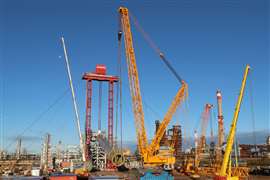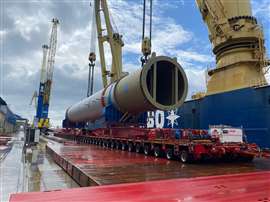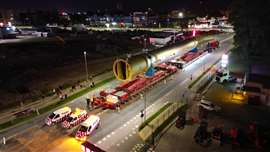Read this article in Français Deutsch Italiano Português Español
Mammoet on the move with Lithuania’s heaviest load
22 May 2024
 With the gantry as the main lifter and the crawler crane tailing, the vessel begins its ascent to vertical. Photo: Mammoet
With the gantry as the main lifter and the crawler crane tailing, the vessel begins its ascent to vertical. Photo: Mammoet
Transporting and installing a 50 metre refinery vessel weighing 1,500 tonnes – in one piece – presented a number of technical challenges met by Mammoet on a project in Lithuania.
After eight years in planning it turned out to be a record-breaking project.
Poland-based European energy and fuel company Orlen’s Lietuva facility in Mažeikiai, Lithuania, is the only refinery in the Baltic states. Back in 2008 Mammoet worked with Orlen on a similar project at the same refinery so it was already familiar with the site.
On this latest project Mammoet was responsible for the refinery vessel’s transport and installation. It was part of a greenfield development to increase production capacity and be more environmentally conscious. The vessel was a residue hydrocracking unit (RHCU), used to get more out of the crude.
 Jumbo using its 900 tonne shipboard cranes to put the refinery vessel straight on to its 88 axle line combinations of modular and conventional trailer. Photo: Mammoet
Jumbo using its 900 tonne shipboard cranes to put the refinery vessel straight on to its 88 axle line combinations of modular and conventional trailer. Photo: Mammoet
The planning started in 2016 when Mammoet considered several ideas with Orlen Lietuva and Lithuania’s transport authority. “We looked at all kinds of different options,” said Edvinas Ivanauskas Mammoet global sales director. “We considered bringing it by water and by a neighboring country. We also considered building a temporary jetty close to the refinery; however, this was not feasible due to the environmental impact assessment. When selecting the best route, you must carry out a lot of investigation in terms of the ground, the bridges and the weather conditions.”
One option was to cut the RHCU and transport it in smaller sections. Welding it back together would have had to be done on site using one of only two specialist welding machines available in Europe. It was designed not to do it this way.
The vessel was shippedby Jumbo from Italy to the city of Klaipeda on Lithuania’s Baltic coast. Jumbo used its 900 tonne capacity cranes onboard its heavy lift ship to unload the RHCU. Before that, however, the quay’s load bearing capacity had to be verified.
“A port is usually six or seven tonnes per square metre for standard operation,” said Ivanauskas. “Basically, we took the approach to strengthen the quay and the areas around it to be able to handle the vessel. We sought special permission from the terminal owner and port authority to get approval.”
 Most of the 145 km move by road had to be done at night to minimise traffic disruption. It took 17 days. Photo: Mammoet
Most of the 145 km move by road had to be done at night to minimise traffic disruption. It took 17 days. Photo: Mammoet
Slowly on the road
The 145 km road trip to the refinery was done on an 88 axle line combination of modular and conventional trailers, pulled by two prime movers. It took 17 days because its average speed was between 3 and 5 km/h and mostly had to be done at night. Mammoet said “this was to avoid damaging the asphalt in the summer heat and to minimise disruption for traffic and the public.”
Even though it was summer, heavy rain before the transport meant steel plates had to be added to the gravel sections of the route. Power cables had to be disconnected along the route. Bridges were another issue, with one new permanent one being constructed and five existing ones having to be reinforced for the passage of the 1,500 tonne vessel, plus the weight of its transporter and prime movers.
At one point along the route there was an 8 per cent slope on unstable gound in a valley. Sheet piling was installed and two more prime movers were added.
Putting it up
On arrival at site the vessel’s installation, using a heavy lift gantry tower system and 1,350 tonne capacity crawler crane, was altogether easier, Mammoet said. First, the vessel was lifted by the Liebherr LR 11350 and the gantry in tandem, allowing the trailers to be driven out from underneath.
With the trailers out of the way the gantry began its work for the main lift with the crawler crane tailing. On schedule, it took about seven hours to get the vessel vertical and placed on its base.
The RHCU was the heaviest load ever transported in Lithuania and it was the first time a heavy lift gantry tower system of this type had been used in the country, Mammoet said.
“The team did a fantastic job delivering a challenging project safely and efficiently, while managing the huge interest from the press and government agencies, which put extra attention and pressure on the project,” Ivanauskas explained.“Our customer has been highly appreciative of what we’ve done and how we delivered the project. I’d like to give a personal thank you to everyone who has contributed to it. It was a great job and an important one for Lithuania.”
 Mammoet was appointed by Orlen Lietuva to be its engineering and logistics partner for the Mažeikiai refinery expansion project. Photo: Mammoet
Mammoet was appointed by Orlen Lietuva to be its engineering and logistics partner for the Mažeikiai refinery expansion project. Photo: Mammoet
STAY CONNECTED


Receive the information you need when you need it through our world-leading magazines, newsletters and daily briefings.
CONNECT WITH THE TEAM












